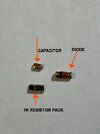To test the diode, use a 10k resistor in series with a 12-15v source to put current through the diode and see what the voltage is directly across the diode. Flip the diode around and repeat. Silicon junctions are around 0.6v, germanium junctions are around .3v. The resistor will limit the current so the diode don't burn up.
Silicon is typically used for signal switching and large signal rectification and germanium is used for small/weak signal detecting when it is beneficial to have it turn on at a lower voltage.
A regular diode will conduct one way (putting either 0.6v for silicon or 0.3v for germanium across the diode) and not conduct in the other direction (you will see the full supply voltage across it).
If it is a zener diode, you will see the silicon 0.6v drop in one direction and the zener voltage drop in the other (assuming it zeners lower than the supply voltage you are using).
As for testing the capacitor, depending on value, a simple DMM probably could tell you the capacitance. If it don't, there are other ways to measure it (like manually measuring its RC time constant with a known R, or resonant frequency with a known L). You could even put it in series with another capacitor of known value and measure the voltage divider at some AC frequency...


